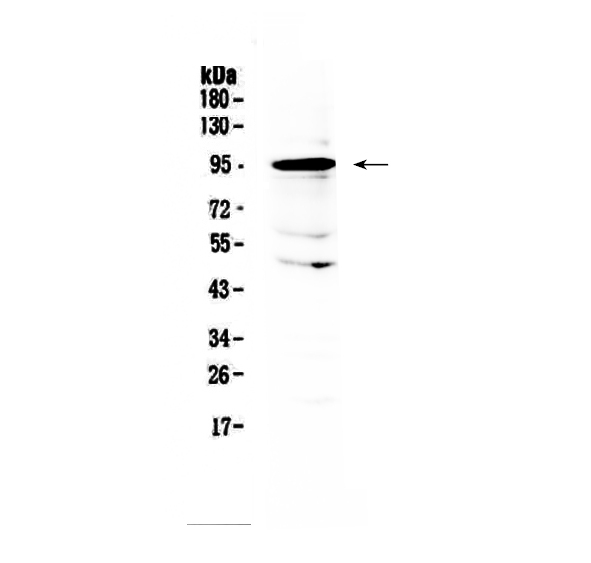Anti-AMOTL2 Picoband Antibody
- SPECIFICATION
- CITATIONS
- PROTOCOLS
- BACKGROUND

Application
| WB, E |
|---|---|
| Primary Accession | Q9Y2J4 |
| Host | Rabbit |
| Reactivity | Human, Mouse, Rat |
| Clonality | Polyclonal |
| Format | Lyophilized |
| Description | Rabbit IgG polyclonal antibody for AMOTL2 detection. Tested with WB, Direct ELISA in Human;Mouse;Rat. |
| Reconstitution | Add 0.2ml of distilled water will yield a concentration of 500ug/ml. |
| Gene ID | 51421 |
|---|---|
| Other Names | Angiomotin-like protein 2, Leman coiled-coil protein, LCCP, AMOTL2, KIAA0989 |
| Calculated MW | 85764 Da |
| Application Details | Western blot, 0.1-0.5 µg/ml Direct ELISA, 0.1-0.5 µg/ml |
| Subcellular Localization | Recycling endosome. |
| Contents | Each vial contains 4mg Trehalose, 0.9mg NaCl, 0.2mg Na2HPO4, 0.05mg NaN3. |
| Immunogen | E. coli-derived human AMOTL2 recombinant protein (Position: A401-Q480). |
| Cross Reactivity | No cross reactivity with other proteins. |
| Storage | At -20˚C; for one year. After r˚Constitution, at 4˚C; for one month. It˚Can also be aliquotted and stored frozen at -20˚C; for a longer time. Avoid repeated freezing and thawing. |
| Name | AMOTL2 (HGNC:17812) |
|---|---|
| Synonyms | KIAA0989 |
| Function | Regulates the translocation of phosphorylated SRC to peripheral cell-matrix adhesion sites. Required for proper architecture of actin filaments. Plays a role in coupling actin fibers to cell junctions in endothelial cells and is therefore required for correct endothelial cell morphology via facilitating transcellular transmission of mechanical force resulting in endothelial cell elongation (By similarity). Required for the anchoring of radial actin fibers to CDH1 junction complexes at the cell membrane which facilitates organization of radial actin fiber structure and cellular response to contractile forces (PubMed:28842668). This contributes to maintenance of cell area, size, shape, epithelial sheet organization and trophectoderm cell properties that facilitate blastocyst zona hatching (PubMed:28842668). Inhibits the Wnt/beta-catenin signaling pathway, probably by recruiting CTNNB1 to recycling endosomes and hence preventing its translocation to the nucleus. Participates in angiogenesis. Activates the Hippo signaling pathway in response to cell contact inhibition via interaction with and ubiquitination by Crumbs complex-bound WWP1 (PubMed:34404733). Ubiquitinated AMOTL2 then interacts with LATS2 which in turn phosphorylates YAP1, excluding it from the nucleus and localizing it to the cytoplasm and tight junctions, therefore ultimately repressing YAP1-driven transcription of target genes (PubMed:17293535, PubMed:21205866, PubMed:26598551). Acts to inhibit WWTR1/TAZ transcriptional coactivator activity via sequestering WWTR1/TAZ in the cytoplasm and at tight junctions (PubMed:23911299). Regulates the size and protein composition of the podosome cortex and core at myofibril neuromuscular junctions (PubMed:23525008). Selectively promotes FGF-induced MAPK activation through SRC (PubMed:17293535). May play a role in the polarity, proliferation and migration of endothelial cells. |
| Cellular Location | Recycling endosome {ECO:0000250|UniProtKB:A1YB07}. Cytoplasm. Cell projection, podosome {ECO:0000250|UniProtKB:Q8K371}. Cell junction |

Thousands of laboratories across the world have published research that depended on the performance of antibodies from Abcepta to advance their research. Check out links to articles that cite our products in major peer-reviewed journals, organized by research category.
info@abcepta.com, and receive a free "I Love Antibodies" mug.
Provided below are standard protocols that you may find useful for product applications.
Background
Angiomotin-like protein 2 is a protein that in humans is encoded by the AMOTL2 gene. Angiomotin is a protein that binds angiostatin, a circulating inhibitor of the formation of new blood vessels (angiogenesis). It mediates angiostatin inhibition of endothelial cell migration and tube formation in vitro. The protein encoded by this gene is related to angiomotin and is a member of the motin protein family. Alternative splicing results in multiple transcript variants of this gene.
If you have used an Abcepta product and would like to share how it has performed, please click on the "Submit Review" button and provide the requested information. Our staff will examine and post your review and contact you if needed.
If you have any additional inquiries please email technical services at tech@abcepta.com.













 Foundational characteristics of cancer include proliferation, angiogenesis, migration, evasion of apoptosis, and cellular immortality. Find key markers for these cellular processes and antibodies to detect them.
Foundational characteristics of cancer include proliferation, angiogenesis, migration, evasion of apoptosis, and cellular immortality. Find key markers for these cellular processes and antibodies to detect them. The SUMOplot™ Analysis Program predicts and scores sumoylation sites in your protein. SUMOylation is a post-translational modification involved in various cellular processes, such as nuclear-cytosolic transport, transcriptional regulation, apoptosis, protein stability, response to stress, and progression through the cell cycle.
The SUMOplot™ Analysis Program predicts and scores sumoylation sites in your protein. SUMOylation is a post-translational modification involved in various cellular processes, such as nuclear-cytosolic transport, transcriptional regulation, apoptosis, protein stability, response to stress, and progression through the cell cycle. The Autophagy Receptor Motif Plotter predicts and scores autophagy receptor binding sites in your protein. Identifying proteins connected to this pathway is critical to understanding the role of autophagy in physiological as well as pathological processes such as development, differentiation, neurodegenerative diseases, stress, infection, and cancer.
The Autophagy Receptor Motif Plotter predicts and scores autophagy receptor binding sites in your protein. Identifying proteins connected to this pathway is critical to understanding the role of autophagy in physiological as well as pathological processes such as development, differentiation, neurodegenerative diseases, stress, infection, and cancer.


